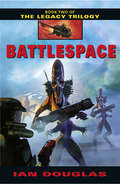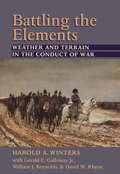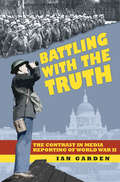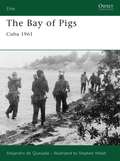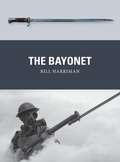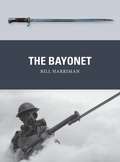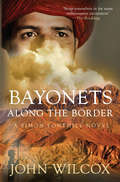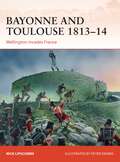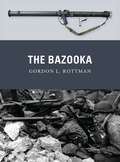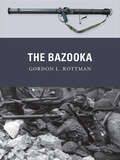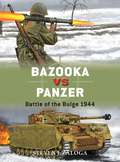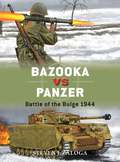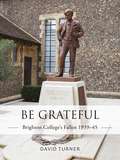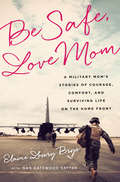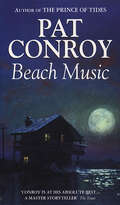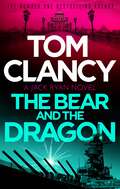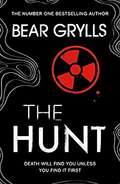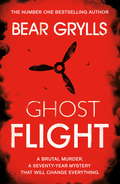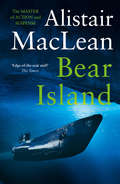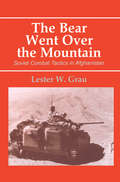- Table View
- List View
Battlespace: Book Two Of The Legacy Trilogy (The Legacy Trilogy #2)
by Ian DouglasWhen called to do battle many light years from home, the 1st Marine Interstellar Expeditionary Unit rose to the challenge – and now thousands of enslaved humans have been freed, but the earth has moved on…
Battling the Elements: Weather and Terrain in the Conduct of War
by Harold A. WintersThroughout history, from Kublai Khan's attempted invasions of Japan to Rommel's desert warfare, military operations have succeeded or failed on the ability of commanders to incorporate environmental conditions into their tactics. In Battling the Elements, geographer Harold A. Winters and former U.S. Army officers Gerald E. Galloway Jr., William J. Reynolds, and David W. Rhyne, examine the connections between major battles in world history and their geographic components, revealing what role factors such as weather, climate, terrain, soil, and vegetation have played in combat. Each chapter offers a detailed and engaging explanation of a specific environmental factor and then looks at several battles that highlight its effects on military operations. As this cogent analysis of geography and war makes clear, those who know more about the shape, nature, and variability of battleground conditions will always have a better understanding of the nature of combat and at least one significant advantage over a less knowledgeable enemy.
Battling With the Truth: The Contrast in the Media Reporting of World War II
by Ian Garden‘Think of the press as a great keyboard on which the government can play.’ – Joseph Goebbels, Reich Minister of Public Enlightenment and Propaganda Dunkirk, Stalingrad, the Dieppe Raid: there were many bloody and gruesome conflicts fought during the Second World War, yet there was one vital and aggressive battle in which no blood was directly shed – that of the warring nations’ battle with the truth. In Battling With the Truth (a follow-up to The Third Reich’s Celluloid War) Ian Garden offers fascinating insights into the ways by which both the Axis and Allies manipulated military and political facts for their own ends. By analysing key incidents and contemporary sources from both British and German perspectives, he reveals how essential information was concealed from the public. Asking how both sides could have believed they were fighting a just war, Garden exposes the extent to which their peoples were told downright lies or fed very carefully worded versions of the truth. Often these ‘versions’ gave completely false impressions of the success or failure of missions – even whole campaigns. Ultimately, Battling With the Truth demonstrates that almost nothing about war is as clear-cut as the reporting at the time makes out. From the past, we can learn valuable lessons about the continuing potential for media manipulation and political misinformation – especially during wartime.
The Bay of Pigs: Cuba 1961 (Elite)
by Stephen Walsh Alejandro De QuesadaThe landings by the Cuban exile Assault Brigade 2506 at the Bay of Pigs on April 17, 1961 led to three days of savage but unequal combat. Before they even sailed for Cuba, a White House decision had condemned them to constant attacks by Castro's air force, which sank two of their ships loaded with vital supplies and equipment. Despite stubborn resistance to Castro's troops and tanks, and heroic sorties by Cuban and American B-26 pilots, the Brigade was strangled for lack of firepower and ammunition. Their story is illustrated with rare photos from Brigade veterans, and detailed color plates of the uniforms and insignia of both sides.
The Bayonet (Weapon)
by Bill HarrimanAlthough muskets delivered devastating projectiles at comparatively long ranges, their slow rate of fire left the soldier very vulnerable while reloading, and early muskets were useless for close-quarter fighting. Consequently, European infantry regiments of the 17th century were composed of both musketeers and pikemen, who protected the musketeers while loading but also formed the shock component for close-quarter combat. The development of the flintlock musket produced a much less cumbersome and faster-firing firearm. When a short knife was stuck into its muzzle, every soldier could be armed with a missile weapon as well as one that could be used for close combat. The only disadvantage was that the musket could not be loaded or fired while the plug bayonet was in place. The socket bayonet solved this problem and the musket/bayonet combination became the universal infantry weapon from c.1700 to c.1870. The advent of shorter rifled firearms saw the attachment of short swords to rifle barrels. Their longer blades still gave the infantryman the 'reach' that contemporaries believed he needed to fend off cavalry attacks. The perfection of the small-bore magazine rifle in the 1890s saw the bayonet lose its tactical importance, becoming smaller and more knife-like, a trend that continued in the world wars. When assault rifles predominated from the 1950s onwards, the bayonet became a weapon of last resort. Its potential usefulness continued to be recognized, but its blade was often combined with an item with some additional function, most notably a wire-cutter. Ultimately, for all its fearsome reputation as a visceral, close-quarter fighting weapon, the bayonet's greatest impact was actually as a psychological weapon. Featuring full-colour artwork as well as archive and close-up photographs, this is the absorbing story of the complementary weapon to every soldier's firearm from the army of Louis XIV to modern-day forces in all global theatres of conflict.
The Bayonet (Weapon)
by Bill HarrimanAlthough muskets delivered devastating projectiles at comparatively long ranges, their slow rate of fire left the soldier very vulnerable while reloading, and early muskets were useless for close-quarter fighting. Consequently, European infantry regiments of the 17th century were composed of both musketeers and pikemen, who protected the musketeers while loading but also formed the shock component for close-quarter combat. The development of the flintlock musket produced a much less cumbersome and faster-firing firearm. When a short knife was stuck into its muzzle, every soldier could be armed with a missile weapon as well as one that could be used for close combat. The only disadvantage was that the musket could not be loaded or fired while the plug bayonet was in place. The socket bayonet solved this problem and the musket/bayonet combination became the universal infantry weapon from c.1700 to c.1870. The advent of shorter rifled firearms saw the attachment of short swords to rifle barrels. Their longer blades still gave the infantryman the 'reach' that contemporaries believed he needed to fend off cavalry attacks. The perfection of the small-bore magazine rifle in the 1890s saw the bayonet lose its tactical importance, becoming smaller and more knife-like, a trend that continued in the world wars. When assault rifles predominated from the 1950s onwards, the bayonet became a weapon of last resort. Its potential usefulness continued to be recognized, but its blade was often combined with an item with some additional function, most notably a wire-cutter. Ultimately, for all its fearsome reputation as a visceral, close-quarter fighting weapon, the bayonet's greatest impact was actually as a psychological weapon. Featuring full-colour artwork as well as archive and close-up photographs, this is the absorbing story of the complementary weapon to every soldier's firearm from the army of Louis XIV to modern-day forces in all global theatres of conflict.
Bayonets Along the Border: A Simon Fonthill Novel (Simon Fonthill #10)
by John WilcoxNorth West India, July 1897. Simon and Alice Fonthill are travelling with their old friend Jenkins to Marden, India for a 50th anniversary party with the Guides Corps. What begins as a peaceful journey becomes a dangerous battle as they find themselves ambushed by four Pathans. On arrival at Marden, their suspicions of conflict are confirmed as they are told of fresh trouble from the Pathans leading Simon and his comrade, 352 Jenkins, to join the charge in protecting a nearby fort.Afterwards, their respite is short-lived when Simon is tasked by Viceroy Elgin to deliver a very important letter to the Amir in Kabul. For her safety, Alice only travels as far as fort Landi Kotal in the Khyber Pass. But strife prevails throughout the land; tribe fights with tribe and every man is a soldier ready to bloody his hands. Undertaking his mission in Kabul, Fonthill learns from the Amir that an army is heading towards the Pass to seize the forts and will undoubtedly leave most for dead.Can Fonthill and Jenkins battle their way back across the Pass to the fort? And will they make it in time to rescue Alice or will the merciless Pathans get there first?
Bayonne and Toulouse 1813–14: Wellington invades France (Campaign #266)
by Peter Dennis Colonel Nick LipscombeThe news of Wellington's momentous victory at Vitoria on 21 June 1813 reached London in early July. Celebration spawned an expectation of a rapid conclusion to events in the Peninsula. His Majesty's Government gave authority for Wellington to invade France and made noises and plans for the redeployment of the Peninsular Army in support of Russia and Prussia. Wellington, however, did not see things in quite the same way. His army was worn out and there remained sizeable French forces in Spain, so what followed had to be a carefully thought out and planned campaign. The invasion itself commenced with the daring Allied crossing of the Bidassoa estuary in early October 1813 and was followed by an operational pause prior to the Battle of Nivelle in November. The subsequent operations, which commenced early in 1814, provided the aftermath to the invasion and the conclusion to the Peninsular War. These actions focus primarily on the investment of Bayonne and the pursuit of Soult's army east, and include the battles and engagements at Garris, Orthez, Aire, Tarbes and the final showdown at Toulouse in April 1814.
Bayonne and Toulouse 1813–14: Wellington invades France (Campaign #266)
by Peter Dennis Nick LipscombeThe news of Wellington's momentous victory at Vitoria on 21 June 1813 reached London in early July. Celebration spawned an expectation of a rapid conclusion to events in the Peninsula. His Majesty's Government gave authority for Wellington to invade France and made noises and plans for the redeployment of the Peninsular Army in support of Russia and Prussia. Wellington, however, did not see things in quite the same way. His army was worn out and there remained sizeable French forces in Spain, so what followed had to be a carefully thought out and planned campaign. The invasion itself commenced with the daring Allied crossing of the Bidassoa estuary in early October 1813 and was followed by an operational pause prior to the Battle of Nivelle in November. The subsequent operations, which commenced early in 1814, provided the aftermath to the invasion and the conclusion to the Peninsular War. These actions focus primarily on the investment of Bayonne and the pursuit of Soult's army east, and include the battles and engagements at Garris, Orthez, Aire, Tarbes and the final showdown at Toulouse in April 1814.
The Bazooka (Weapon)
by Gordon L. Rottman Johnny Shumate Alan GillilandMost belligerents entering World War II armed their infantry with bulky and ineffectual anti-tank rifles as their primary means of combating tanks. US planners realized that what infantrymen needed was a relatively lightweight, man-portable anti-tank weapon that was simple to operate, accurate, and capable of knocking out the average tank at a reasonable range, while also being effective against fortified buildings, pillboxes, and personnel in the open. The bazooka combined a revolutionary new anti-tank rifle-grenade warhead, a much-modified British anti-aircraft rocket motor, and a cobbled-together launcher tube and electrical firing system; its first test-firing astounded observers, and it was immediately adopted by the US armed forces. Featuring specially drawn colour artwork, this engaging study tells the story of the bazooka, which set the standard for future light anti-tank weapons and their ammunition, and was a key influence on anti-tank tactics and techniques in the post-war era.
The Bazooka (Weapon)
by Gordon L. Rottman Johnny Shumate Alan GillilandMost belligerents entering World War II armed their infantry with bulky and ineffectual anti-tank rifles as their primary means of combating tanks. US planners realized that what infantrymen needed was a relatively lightweight, man-portable anti-tank weapon that was simple to operate, accurate, and capable of knocking out the average tank at a reasonable range, while also being effective against fortified buildings, pillboxes, and personnel in the open. The bazooka combined a revolutionary new anti-tank rifle-grenade warhead, a much-modified British anti-aircraft rocket motor, and a cobbled-together launcher tube and electrical firing system; its first test-firing astounded observers, and it was immediately adopted by the US armed forces. Featuring specially drawn colour artwork, this engaging study tells the story of the bazooka, which set the standard for future light anti-tank weapons and their ammunition, and was a key influence on anti-tank tactics and techniques in the post-war era.
Bazooka vs Panzer: Battle of the Bulge 1944 (Duel)
by Steven J. Zaloga Johnny Shumate Alan GillilandWorld War II saw tanks assume a dominant role in warfare, capable of tearing through the enemy lines if left unchecked. To combat the threat posed by these armoured behemoths the United States developed the M1 Anti-Tank Rocket Launcher, better known as the Bazooka. First employed in combat during 1942, the weapon required a great deal of skill and courage to use effectively. By late 1944 it was a mainstay of the US infantry's anti-tank capabilities, alongside towed weapons, anti-tank grenades and other longer-established measures.Focusing on the savage close-quarters fighting between Germany's armoured divisions and the US infantry during the Battle of the Bulge, Steven Zaloga's absorbing study compares and assesses the strengths and limitations of the cutting-edge technology used by both sides. Featuring specially commissioned full-colour artwork and explosive battle reports, this volume casts new light on the evolving nature of infantry-versus-tank combat in the closing months of World War II.
Bazooka vs Panzer: Battle of the Bulge 1944 (Duel #77)
by Steven J. Zaloga Johnny Shumate Alan GillilandWorld War II saw tanks assume a dominant role in warfare, capable of tearing through the enemy lines if left unchecked. To combat the threat posed by these armoured behemoths the United States developed the M1 Anti-Tank Rocket Launcher, better known as the Bazooka. First employed in combat during 1942, the weapon required a great deal of skill and courage to use effectively. By late 1944 it was a mainstay of the US infantry's anti-tank capabilities, alongside towed weapons, anti-tank grenades and other longer-established measures.Focusing on the savage close-quarters fighting between Germany's armoured divisions and the US infantry during the Battle of the Bulge, Steven Zaloga's absorbing study compares and assesses the strengths and limitations of the cutting-edge technology used by both sides. Featuring specially commissioned full-colour artwork and explosive battle reports, this volume casts new light on the evolving nature of infantry-versus-tank combat in the closing months of World War II.
The BBC German Service during the Second World War: Broadcasting to the Enemy (Palgrave Studies in the History of the Media)
by Vike Martina PlockThis book, part media history and part group biography, tells the story of the BBC’s attempts to reach out to listeners in Nazi Germany at a time when Anglo-German relations were particularly strained. Who were the individuals behind the microphone, whose names could only be mentioned in whispered conversations on the continent? Who wrote the satirical sketches that offered comic relief to housewives struggling to obtain enough food to feed their families? And who made decisions about programme delivery and staffing? Drawing extensively on previously unexamined archival material, The BBC German Service during the Second World War: Broadcasting to the Enemy sheds light on the complex, often difficult working arrangements at the wartime BBC where people from different nationalities and socio-political backgrounds collaborated and argued about the delivery of an effective propaganda programme that would assist the Allies in defeating the Nazis.
Be Grateful: Brighton College's Fallen 1939–45
by David TurnerEighty years on from the beginning of the Second World War it is easy to forget that, for a time, democracy, the rule of law and even everyday values of tolerance and kindness were in danger of being snuffed out in Europe.Given the sacrifices made, we must not forget the people who fought to protect these virtues – particularly those who laid down their lives for this cause. To this end, all Fourth Form pupils at Brighton College have researched an individual Old Brightonian who died in, or as a result of, the war. The list includes former masters, pupils and one German old boy who was doubtless a good man, but fighting for a bad cause.What emerges in this book, a companion to a volume on the fallen of the Great War already published, is a collection of extremely varied personal histories. Where possible, this book recalls the family lives of each man in addition to his war service. The quality of research has been high, and pupils have also excelled at storytelling: finding the excitement and humour in each life, as well as the poignancy. The 170 fallen Old Brightonians of the Second World War, nurtured by the College but cut off in their prime, have been honoured by the current crop of Brightonians, several generations below them.
Be Grateful: Brighton College's Fallen 1939–45
by David TurnerEighty years on from the beginning of the Second World War it is easy to forget that, for a time, democracy, the rule of law and even everyday values of tolerance and kindness were in danger of being snuffed out in Europe.Given the sacrifices made, we must not forget the people who fought to protect these virtues – particularly those who laid down their lives for this cause. To this end, all Fourth Form pupils at Brighton College have researched an individual Old Brightonian who died in, or as a result of, the war. The list includes former masters, pupils and one German old boy who was doubtless a good man, but fighting for a bad cause.What emerges in this book, a companion to a volume on the fallen of the Great War already published, is a collection of extremely varied personal histories. Where possible, this book recalls the family lives of each man in addition to his war service. The quality of research has been high, and pupils have also excelled at storytelling: finding the excitement and humour in each life, as well as the poignancy. The 170 fallen Old Brightonians of the Second World War, nurtured by the College but cut off in their prime, have been honoured by the current crop of Brightonians, several generations below them.
Be Safe, Love Mom: A Military Mom's Stories of Courage, Comfort, and Surviving Life on the Home Front
by Elaine Lowry BryeThis essential guide for all military families provides helpful advice and reassurance on topics ranging from boot camp, to deployment, to PTSD, from a former "Army brat" turned mother of four military kids.When you enlist in the United States military, you don't just sign up for duty; you also commit your loved ones to lives of service all their own.No one knows this better than Elaine Brye, an "Army brat" turned military wife and the mother of four officers-one each in the Army, Navy, Air Force, and Marine Corps. For more than a decade she's endured countless teary goodbyes, empty chairs at Thanksgiving dinners, and sleepless hours waiting for phone calls in the night. She's navigated the complicated tangle of emotions that are part and parcel of life as a military mother.Be Safe, Love Mom braids together Elaine's own personal experiences with those of fellow parents she's met along the way. She offers gentle guidance and hard-earned wisdom on topics ranging from that first anxious goodbye to surrendering all control of your child, from finding comfort in the support of the military community and the healing power of faith to coping with the enormous sacrifices life as a military mother requires.With hard-to-come-by information and encouragement that is like advice from a wise and trusted friend, Be Safe, Love Mom is an essential handbook to membership in a strong and special sisterhood.
Beach Music: A Novel (Le\livre De Poche Ser.)
by Pat ConroyWith the spectacular worldwide success of his unforgettable novel The Prince of Tides, Pat Conroy established himself as a major international writer. He is known for his anguished and painfully honest insights into families and the human heart. He now returns with Beach Music, a story which tells of a family haunted by dark memories that reach back into the unutterable terrors of the Holocaust.Jack McCall, an American living in Rome with his young daughter, is trying to find peace after the recent trauma of his wife's suicide. But his solitude is disturbed by the appearance of his sister-in-law, who begs him to return home, and of two school friends, who want his help in tracking down another classmate who went underground as a Vietman protester and never resurfaced. These requests launch Jack on a journey that encompasses the past and the present in both Europe and the American South: a quest that leads him to shocking and ultimately liberating truths.
The Bear and the Dragon (Jack Ryan #8)
by Tom Clancy'Exhilarating' Sunday TimesNewly elected as President, domestic pitfalls await Jack Ryan around every corner. Now, in Moscow, someone may have tried to take out the chairman of the SVR - the former KGB - with a rocket-propelled grenade. Even more disturbing is the potential identity of the assassin. Were they political enemies, the Russian Mafia, disaffected former KGB? Or, Ryan wonders, is something far more dangerous at work here?He is right to wonder. For even while Russian investigators pursue the case, forces in China are moving forward with a plan of truly audacious proportions. If they succeed, the world as we know it will never look the same. If they fail. . . the consequences may be unspeakable.
Bear Grylls: Amazing Shoutline To Come
by Bear GryllsTHE HUNT IS ON FOR JAEGER 1945, and the Nazis' grand plans are in disarray. Defeat is imminent, so in a last attempt to protect their legacy, the high command hides their store of uranium deep underground, ready for them to fight another day.2018, and ex-SAS soldier Will Jaeger stumbles upon this horrible truth. But the uranium is missing and, when he learns his wife Ruth has also been kidnapped, he's certain the enemy is on the move once more.That much uranium in the wrong hands could devastate the world. It's up to Jaeger and his team to find it before their worst fears are realised. But the enemy is always one step ahead, pushing Jaeger to the limit of his endurance.The danger is real, and the people who hold Ruth have a score to settle. It's a race against time.And the clock is ticking . . . * * * * * * * *What readers say about Bear Grylls:'bloody brilliant! Absolute page turner, haven't been able to put it down' Goodreads review of Ghost Flight, 5 stars'Bond and Bourne have good company in Jaeger' Amazon review of Burning Angels, 5 stars 'Will resonate with fans of classic spy thrillers' Mail on Sunday'Great action and what an amazing story' Amazon review of Burning Angels, 5 stars 'watch out Dirk Pitt or Jack Reacher, there's a new man on the block' Goodreads review of Ghost Flight, 5 stars'Unputdownable!' Sir Ranulph Fiennes'will keep you reading well into the early hours of the morning' Goodreads review of Burning Angels'Will Jeager is James Bond on steroids' Goodreads review of Burning Angels, 5 stars'Couldn't stop reading this book, every lunch break I was reading away!' Amazon review of Ghost Flight, 5 stars'A gripping thriller set in the darkest of days' Jonathan Ross
Bear Grylls: Ghost Flight
by Bear Grylls'Unputdownable!' Sir Ranulph Fiennes* * * * * * *A murder. A mystery that will change everything.Will Jaeger's family are gone, and they're not coming back.But there's one thing he can fix. His best friend has been found dead, and he's going to catch the monsters that killed him.To do it, Jaeger assembles an expert team of ex-SAS soldiers. They must head deep into the Amazon rainforest. It seems his friend was on the trail of an old Nazi bomber.And someone definitely wants it kept secret. As things go wrong, and Jaeger closes the net on his friend's killer, he comes to realise one thing.Everything is connected. And, for one man, the War never ended . . .A modern, edge-of-your-seat thriller, shrouded in the shadows cast by Nazi Germany. Great for fans of Gregg Hurwitz, James Swallow, and I Am Pilgrim.* * * * * * * What readers are saying about BEAR GRYLLS: GHOST FLIGHT:'A gripping thriller set in the darkest of days', Jonathan Ross'Men don't come much tougher than daredevil climber and adventurer, Bear Grylls', SUN'A great adventure, superbly written!' Amazon reviewer, 5 stars'If you want a page-turning, action packed adventure story with hints of WWII then look no further', Amazon reviewer, 5 stars'Will resonate with fans of classic spy thrillers', MAIL ON SUNDAY'I loved it from beginning to end, and I can't wait to read what happens next', Goodreads reviewer, 5 stars'Once I finished this one I went straight back & got the next in the Will Jaeger series!', Amazon reviewer, 5 stars
Bear Island: Night Without End, Ice Station Zebra, Bear Island, Athabasca
by Alistair MacLeanThe classic tale of adventure and death on a mysterious Arctic island, from the acclaimed master of action and suspense.
The Bear Went Over the Mountain: Soviet Combat Tactics in Afghanistan
by Lester W. GrauThis collection of vignettes was written by Soviet junior officers describing their experiences fighting the Mujahideen guerillas. It is not a history of the Soviet-Afghan war, but snapshots of combat as seen by young platoon leaders, company commanders, battalion commanders and military advisers.
The Bear Went Over the Mountain: Soviet Combat Tactics in Afghanistan
by Lester W. GrauThis collection of vignettes was written by Soviet junior officers describing their experiences fighting the Mujahideen guerillas. It is not a history of the Soviet-Afghan war, but snapshots of combat as seen by young platoon leaders, company commanders, battalion commanders and military advisers.
The Bear Who Went To War (PDF)
by Alan Pollock Bryony ThomsonBased on the true story of the Iranian bear cub adopted by Polish soldiers in World War 2, who travelled with them across Europe, carried armaments at the Battle of Montecassino and finally found a safe home with them in Scotland.
